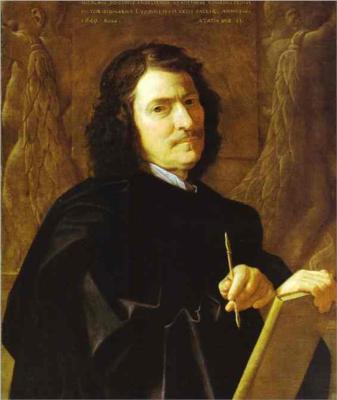
Nicolas Poussin (June 1594–November 19, 1665) was a French painter. Poussin was the founder and greatest practitioner of 17th century French classical painting. His work symbolizes the virtues of clarity, logic, and order. It has influenced the course of French art up to the present day.He spent most of his working life painting in Rome except for a short period when Cardinal Richelieu ordered him back to France as Painter for the King.Until the 20th century he remained the dominant inspiration for such classically oriented artists as Jacques Louis David and Paul Cezanne.
He was born near Les Andelys, now in the Eure département, in Normandy. Early sketches attracted the notice of Quentin Varin, a local painter, whose pupil Poussin became, till he went to Paris, where he entered the studio of Ferdinand Elle, a Fleming, and then of the Lorrainer L'Allemand. He found French art in a stage of transition: the old apprenticeship system was disturbed, and the academical schools destined to supplant it were not yet established; but, having met Courtois the mathematician, Poussin was fired by the study of his collection of engravings after Italian masters.After two abortive attempts to reach Rome, he fell in with the chevalier Marini at Lyon. Marini employed him on illustrations to his poems, took him into his household, and in 1624 enabled Poussin (who had been detained by commissions in Lyon and Paris) to rejoin him at Rome. There, his patron having died, Poussin fell into great distress. Falling ill he was received into the house of his compatriot Dughet and nursed by his daughter Anna Maria to whom in 1629, Poussin was married.
Among his first patrons were Cardinal Barberini, for whom was painted the Death of Germanicus (Barberini Palace); Cardinal Omodei, for whom he produced, in 1630, the Triumphs of Flora (Louvre); Cardinal de Richelieu, who commissioned a Bacchanal (Louvre); Vicenzo Giustiniani, for whom was executed the Massacre of the Innocents, of which there is a first sketch in the British Museum; Cassiano dal Pozzo, who became the owner of the first series of the Seven Sacraments (Belvoir Castle); and Fiart de Chanteloup, with whom in 1640 Poussin, at the call of Sublet de Noyers, returned to France.Louis XIII conferred on him the title of first painter in ordinary, and in two years at Paris he produced several pictures for the royal chapels (the Last Supper, painted for Versailles, now in the Louvre) and eight cartoons for the Gobelins, the series of the Labors of Hercules for the Louvre, the Triumph of Truth for Cardinal Richelieu (Louvre), and much minor work.
In 1643, disgusted by the intrigues of Simon Vouet, Feuquires and
the architect Lemercier, Poussin withdrew to Rome. There, in 1648,
he finished for De Chanteloup the second series of the Seven Sacraments
(Bridgewater Gallery), and also his noble landscape with Diogenes
throwing away his Scoop (Louvre); in 1649 he painted the Vision
of St Paul (Louvre) for the comic poet Scarron, and in 1651 the
Holy Family (Louvre) for the duke of Crqui. Year by year he continued
to produce an enormous variety of works, many of which are included
in the list given by Flibien. He died in Rome on November 19, 1665
and was buried in the church of St Lawrence in Lucina, his wife
having predeceased him.Poussin left no children, but he adopted
as his son Gaspar Dughet (Gasparo Duche), his wife's brother, who
took the name of Poussin.



